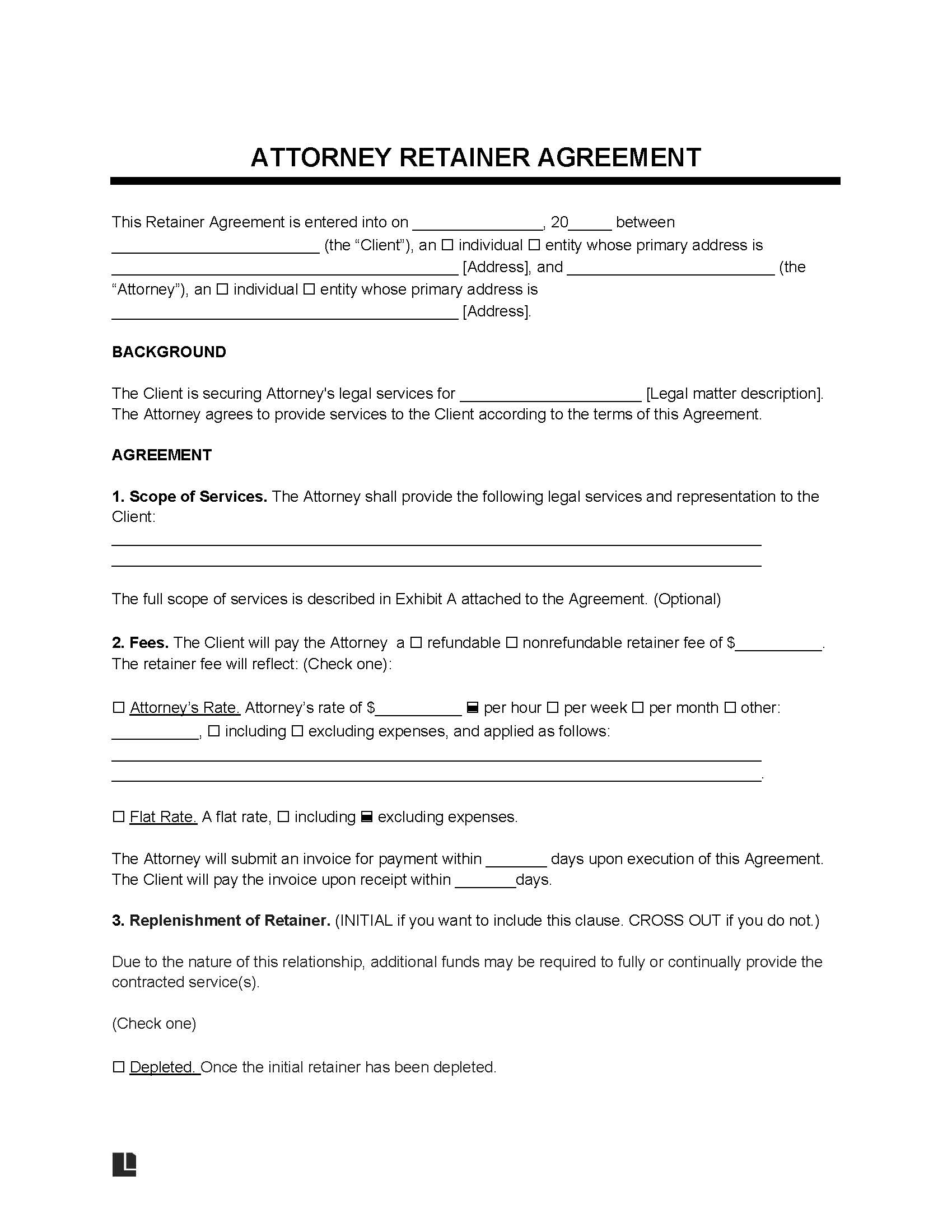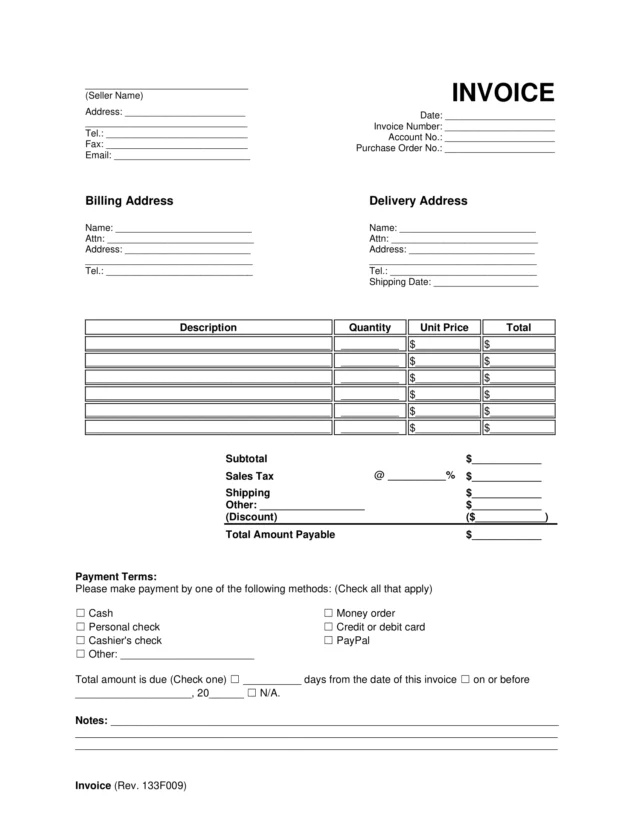What Is a Legal Retainer Agreement?
A legal retainer agreement is a legal document outlining the terms between a client and a law firm (or individual lawyer). It records the two parties’ agreement for the legal services the law firm or lawyer will provide to the client. It explains the scope of work, fees, and other essential details.
This agreement’s value depends on the scope of services the attorney provides. When both parties draft this document and use it to establish their relationship, it can streamline the contracting process and promote transparency.
Writing a Legal Retainer Agreement
A legal retainer agreement can be a stand-alone document, but lawyers often incorporate it into a broader attorney representation agreement.
Key Components of a Legal Retainer Agreement
A lawyer retainer agreement typically includes the following details:
- Client’s name and address
- Attorney’s (or firm’s) name and address
- Agreement date
- Description of the legal matter
- Scope of services the attorney will provide
- Fees, including refundable or nonrefundable retainer, hourly rates, flat fees, and expenses
- Invoicing and payment terms
- Retainer replenishment terms, including threshold and automatic payment terms
- Termination clause
- Terms for confidentiality, governing law, severability, and dispute resolution
- Clause voiding prior discussions, arrangements, and agreements between the parties
- Client and attorney signatures
Fees in Legal Retainer Agreements
The fees in legal retainer agreements depend on the specific arrangement between the client and the lawyer and the legal services the lawyer offers. Here are some fees you may find in this agreement:
- Retainer fee: A retainer is a fee the client pays upfront to reserve an attorney’s professional services. The agreement will note the retainer fee amount and how the lawyer will apply it toward future legal services. The lawyer may refund any unused portion of this fee to the client.
- Flat fees: Flat fees cover specific services, such as drafting a contract or reviewing an estate plan. The agreement should clarify if additional costs will apply if the attorney must perform services outside the defined scope.
- Hourly fees: Lawyers may charge clients a predetermined rate for each hour they work on their case. If a lawyer charges hourly, they should include details on how they track and bill for the time they work. They can use a legal invoice to facilitate timely payments.
- Contingency fees: Contingency fees depend on the outcome of the case. Instead of paying a flat or hourly fee, the client promises to pay the attorney a percentage of any settlement or monetary award they receive in the case. This fee structure is common in cases like medical malpractice or personal injury cases. A lawyer may draft a separate contingency fee agreement.
- Additional costs and expenses: A legal retainer agreement may include guidelines for reimbursing the lawyer for expenses incurred while representing the client, such as travel expenses, expert witness fees, and court filing fees.
How Retainer Fees Are Determined
Lawyers account for various factors to determine the appropriate retainer fees:
- Scope of work: The scope of work, including the research, representation, and tasks the lawyer must complete, influences the retainer fee.
- Effort and time: The lawyer should consider the effort and time they anticipate dedicating to the case, including the time they’ll spend communicating with the client and other parties.
- Complexity: Cases involving extensive documentation, intricate legal topics, and multiple parties may justify higher retainer fees.
- The lawyer’s expertise and experience: A lawyer with more expertise and experience in a specific area of law may be able to charge a higher retainer fee.
- Local market rates: The lawyer should consider the average prices for similar legal services in their area to determine an appropriate retainer fee.
How a Lawyer Retainer Works
The terms of a lawyer retainer agreement vary widely depending on the case details. Typically, a lawyer retainer works as follows:
1. Sign the Legal Retainer Agreement
The attorney and client review and sign the terms of the attorney retainer agreement. To streamline the process, they can begin with a legal retainer agreement template.
2. Receive the Retainer
At the time of the agreement, the client pays the agreed retainer to the attorney. Depending on the agreement’s terms, the client may pay a single retainer as a down payment for the attorney’s services. Alternatively, they may pay a periodic retainer fee to continuously retain the attorneys’ legal assistance, for example, as a legal consultant for a business.
3. Hold the Retainer in Trust
Typically, the attorney holds the retainer in trust while they perform services for the client. They deduct the billable hours and services consistent with the agreement’s terms.
4. Log All Hours and Deduct from the Retainer
Logging hours is critical for transparent accounting when dealing with an attorney retainer agreement. Logging hours ensures the client knows how the lawyer spends their retainer. It also assures them that they’re working on their case, even when progress seems slow.
5. Replenish Retainer at Threshold or Depletion
As the client’s legal matter progresses, it is not unusual for the lawyer to use up the retainer. The legal retainer agreement should specify if the client must replenish the retainer once it reaches a certain threshold or if the lawyer fully depletes it.
6. Invoice for Hourly Services
If there is no clause for retainer replenishment, the attorney may bill for additional services at their hourly rate. The parties should note this arrangement in the retainer agreement. Alternatively, they may draft a new service agreement to include rates and payment terms once the retainer agreement terminates.
Legal Retainer Agreement Sample
Start your contracting process with this fillable legal retainer agreement template, available in PDF and Word format:

Frequently Asked Questions
What are the benefits of a legal retainer agreement?
A legal retainer agreement offers the following benefits:
- Provides a clear scope of work
- Prevents misunderstandings or legal issues arising from vague expectations
- Establishes a solid attorney-client relationship
- Creates a basis for a long-term relationship built on trust
How long do I have to return a retainer?
The time an attorney has to return a retainer depends on your contract’s terms and your state and local laws. Some lawyers must return retainers within 14 or 30 days, while others require the attorney to return the retainer within a reasonable time.
Do I have to refund the retainer if some of it is unused?
You must refund the retainer if it’s refundable per your contract and if there are funds remaining after you deduct the services you provided.
If the retainer is nonrefundable, you may adhere to a client’s request to issue a refund. However, you may retain the right to deny the request, especially if you provided all legal services per the contract.



